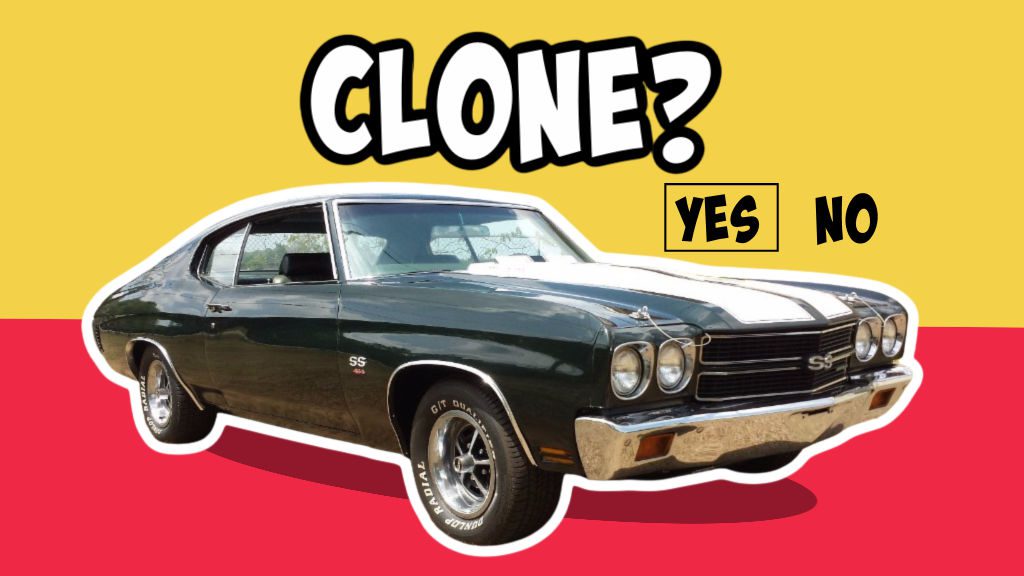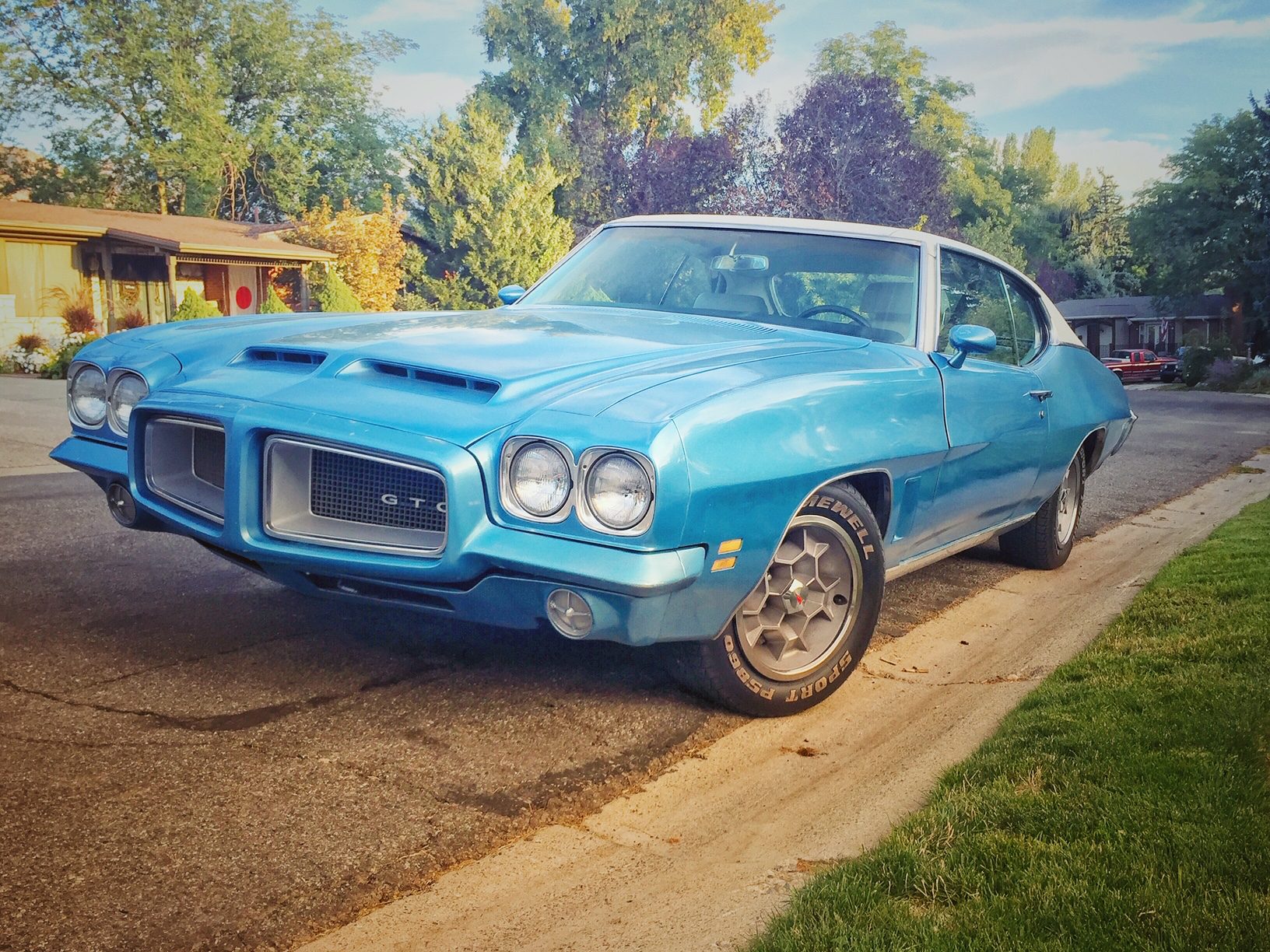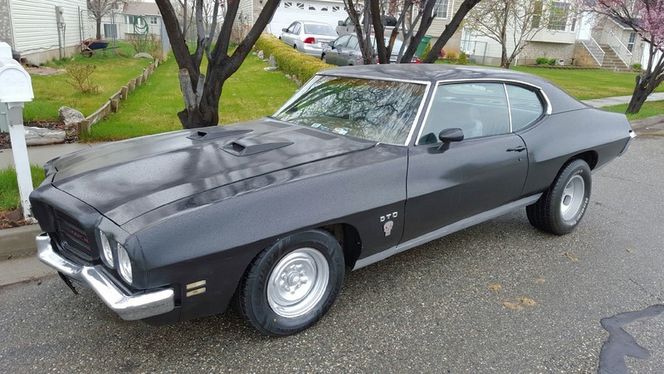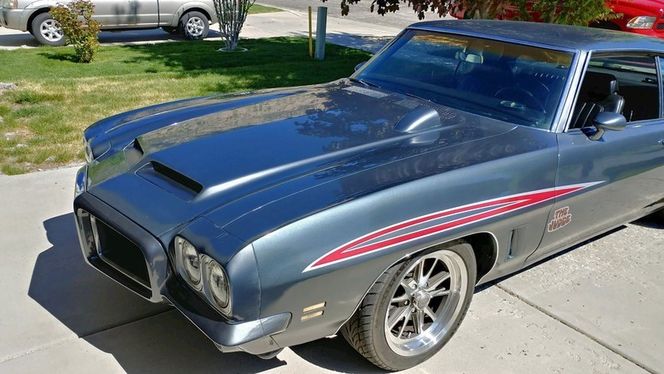
With the rising costs of classic American muscle cars, many enthusiasts are turning to muscle car clones (also known as tributes or recreations) to own and enjoy the ride of their dreams.
Table of Contents
What is a Muscle Car Clone?
A muscle car clone is a recreation that converts a base model sedan, coupe, or convertible by adding cosmetic and performance upgrades that pay tribute to a factory or dealer-optioned muscle car.
Here are three ways one can transform a base model car into a muscle car clone:
Exterior
This is the visual level most people think about when they hear the word “clone” —which is the process of making a base model car look identical to the muscle car version from the outside.
This may include upgrading the exterior with hood scoops, racing stripes, spoilers, fenders, badging, tail lights, bumpers, and grills found exclusively on the muscle car version of the car.
Interior
This level focuses on what’s on the inside, where you create the muscle car experience behind the wheel. Often times interior options were exclusive to the muscle car optioned car.
This may include upgrading base model pieces like dashboards, gauge clusters, emblems, steering wheels, consoles, and door panels to match the interior found within a muscle car.
Performance
The final level is where you don’t have a sheep in wolf clothing. You also transform the motor, drivetrain, and mechanicals from prey to predator.
This may include higher horsepower motors, heavy-duty transmissions, intake manifolds, suspension components, and higher CFM carburetors.
Some clones only have their exterior appearance upgraded, while others leverage all three levels of enhancements, including cosmetic, interior, and performance.
When all three levels are fully executed, it’s virtually impossible to spot a real muscle car from a clone without digging deeper into specific numbers found on the car.
How I Spotted Two Clones in One Day
I owned a 1972 Pontiac GTO, so I’m very familiar with these cars. I did a ton of research before buying mine to know what to look for inside and out.
The original factory build sheet helped me verify this car was a real “Goat.” I checked the VIN, verified it through the Pontiac Historical Society, and confirmed it still had the original matching number motor and heads.
Here is what my legit 1972 Pontiac GTO looked like:

Recently, I was searching through some classifieds looking for a new project. I found two cars advertised for sale as a “1972 Pontiac GTO” on the same day.
Neither listing mentioned that they were clones, and both had “1972 Pontiac GTO” as the headline of their ads.
In fact, the owner of the gray one adamantly stated it wasn’t a clone and was a “true GTO” right at the top of his listing.
However, I’m always suspicious when I read someone specifically call out “True” or “Not a Clone” when no evidence of why that statement is true is provided.
And I’m even more suspicious when the photos look nothing like what is being advertised.
Here is a photo from each listing:


The black one doesn’t even come close to looking like a true 1972 GTO (it looks EXACTLY like a Lemans with bolted-on hood scoops and incorrect GTO badges). Compare this to the blue one above.
The gray one looks identical to a 1972 GTO (except for the Judge stripes and logo unavailable on 1972 models). This looked just like mine save for the rear wing.
The gray one had the correct endura front bumper, hood scoops, and side air vents on the front fenders. By all appearances, it looked correct for a 1972 GTO.
What did I discover?
They were both clones.
How could I tell?
Rather than trusting the listings, I looked at the VIN to tell me the truth. I ALWAYS do this because it is ALWAYS so revealing.
Decoding the VIN on the black one, I could decipher that it was actually a Luxury Lemans with a motor code option that was unavailable on the 1972 GTO.
Again decoding the VIN on the gray one, I deciphered this one as a Lemans, which is a correct base model for the 1972 GTO. However, it also had the wrong motor code to be a true GTO.
I have no idea if these owners were told their car was a GTO (and they believed it), never verified it themselves, or are trying to pass these cars off as real ones while hiding that they’re clones.
I have no clue.
All I know is that is what was in their listing and why it’s so important to verify the numbers readily available in the VIN. More on this is below.
How Can You Spot a Muscle Car Clone?
Spotting a clone from the real thing is getting harder to do.
Truthfully, a whole series of books could be written on all the different visual subtleties in the exterior, interior, and under the hood, which you could use to detect a real from a fake.
That’s because the clues are individual to each car depending on the year, make, and model. Telling the difference requires specific knowledge about what is correct and what isn’t.
Your ability to know the subtleties is most important when purchasing a car so you don’t overpay or purchase something you didn’t expect.
Start by downloading photos of the car’s exterior, interior, and under the hood from Google.
Inspect both versions of the car—inside and out—then compare them side by side to spot key differences. Using this process, you can become a quick expert on both models.
But sometimes, that’s not enough, depending on the lengths the previous owner has gone to clone the vehicle.
To help offset this, here are five methods that go below the surface to help you spot a clone when you cannot tell just by looking at it.
Method 1: Decode the VIN
The Vehicle Identification Number (VIN) is a long rectangular plate with alphanumeric codes stamped into it that is located between the windshield and the dashboard.
The VIN often includes codes that, once decoded, can tell you the manufacturer, model, body type, motor, assembly plant, and vehicle production number.
If the motor or model is listed, that may be all you need to know whether or not a car is a clone. First, verify if the car had a V8 motor in it originally.
For example, if the motor code states a 6-cylinder, you know it originally was a base model car because no self-respecting muscle car ever came with one of those.
There are dozens upon dozens of online resources to help you decode the VIN so you can uncover the original model of the vehicle from the factory.
This VIN decoder does the hard work for you or you can go to Google and type in these formulas to find the resources you need to deconstruct the VIN:
Search Engine VIN Formula
Search Formula: “YEAR + MAKE + MODEL + VIN Decoder”
Example: 1969 AMC Javelin VIN Decoder
Method 2: Verify the Build Sheet
This is the ultimate way to verify the authenticity of any car from this era but is almost like finding a unicorn. In short, they usually are long gone for various reasons outlined below.
The build sheet is a paper document the factory produced so assembly line workers knew exactly what options would be added as they made their way down the line.
The build sheet has the VIN on it and every option the car originally came with from the factory. It’s a wealth of information that documents and authenticates everything related to the car.
Here are some of the details that can be found on a build sheet depending on the options it was ordered with:
- Model
- Motor
- Carburetor
- Transmission
- Exhaust
- Rear axle
- Brakes
- Wheel & Tires
- Tach
- Gauges
- Body color (top and bottom)
- Interior color
- Vinyl top & color
- Seats (bench or buckets)
- Console
- And more
When the car was completed and came off the assembly line, the build sheet was placed in the car. And, these documents were often placed in random places.
Build sheets have been found under the carpet, under the front or rear seat springs, above the headliner or behind a door panel. Some have even been found above the gas tank.
These documents authenticate whether the car was born a base model or a muscle car. And, they can tell you so many other details about the car that you might not have considered.
Unfortunately, these documents are hard to find because owners often discarded them, lost them or deteriorated so much that they have become all but unreadable over time.
However, if you can find one, it will reveal all of its deepest darkest secrets.
Method 3: Decode the Data Plate
Data plates are located either on the firewall or upper fender or inside the driver’s side door jamb. These rectangular plates have alphanumeric codes stamped into them.
Data plates catalog important options including, but not limited to, the model, motor, transmission, brakes, paint, seats, consoles, as well as the vinyl top and interior colors.
Sometimes they tell you the model when the VIN does not. Many online resources can help you decode these data plates.
Here are some tools to help you out:
- Mopar Fender Tag Decoder
- General Motors Decoder
- Ford Dataplate Decoder
- AMC Door Tag Decoder
Visit Google.com and type the following formula into the search bar to find links where you can decode the data plate:
Search Engine Data Plate Decoder Formula
- General Motors Formula: “YEAR + MAKE + MODEL + Data Plate Decoder”. Example: “1969 Chevy Camaro Data Plate Decoder”.
- Ford Formula: “YEAR + MAKE + MODEL + Door Data Plate Decoder”. Example: “1970 Ford Mustang Door Data Plate Decoder”.
- MOPAR Formula: “YEAR + MAKE + MODEL + Fender Tag Decoder”. Example: “1971 Dodge Challenger Fender Tag Decoder”.
- AMC Formula: “YEAR + MAKE + MODEL + Door Tag Decoder”. Example: “1972 AMC AMX Door Tag Decoder”.
Method 4: Check Original Paperwork
If the build sheet isn’t available, there may be other original paperwork available from the original dealership or factory that can also verify important options.
This may include the bill of sale, title, window sticker, or service receipts. If being able to find the build sheet is like finding a unicorn, these documents are like finding a family of Yetis.
A few years ago, I purchased a 1972 Pontiac GTO survivor car with service receipts dating back to the early 1980s documenting its journey from Florida to the east coast to Utah.
The folder was an inch thick and included the build sheet, making authenticating the car extremely easy. I could see exactly what was correct and what wasn’t.
Fortunately, it wasn’t missing much except a few minor exceptions like the wheels, radio, and most of the air conditioning system. All of those were easy to find and relatively easy to replace.
Method 5: Match the Motor to the VIN
After you locate the VIN of the car, you can attempt to match the production number to the one stamped on the motor. If they match, it starts to unlock its pedigree. If not, it’s a different motor.
Remember, no one was thinking about matching numbers to preserve their value in the future. Different motors were often transplanted from newer years with different cubic inches.
You will also want to check the casting codes on the heads and engine block if it matches. Locations vary and can be explained by searching on Google.
Use the following search phrase formulas to discover what motor and heads your car has under the hood and where to find them.
Casting Number Location Formulas
Motor: “Make + Motor Casting Number Location“
Example: Chrysler Motor Casting Number Location
Usually, one of these methods is available to help point you in the direction of whether or not you’re looking at the clone or the real thing.
So how are so many muscle cars still around?
The simplest answer is that they are not what they appear to be.
Why Are There So Many Muscle Car Recreations?
While they captured the hearts of the car magazines at the time, Muscle cars only represented a small fragment of the total production run at the assembly plant.
The 1969 Camaro is a great example. There was 165,226 base Chevy Camaros made that year. However, only 36,309 Super Sport Camaros were made that same year.
And it was no different for GM than it was for Ford, Chrysler, or AMC.
With more base model cars being produced than muscle cars, it stands to reason that more base models have survived than their performance-based counterparts.
Remember, Muscle Cars weren’t always as collectible as they are today and most people treated them like they were disposable. They were used, abused, and left for dead in junkyards.
Because demand is high and factory supply (and survivorship) is low, the prices of factory-born Muscle Cars have boomed to the point of becoming unreachable for the average enthusiast.
However, reproduction parts catalogers and the advent of the internet have made it easier than ever to find what you need to build an identical cloned muscle car from a base model car.
As a result, people are turning to buying or building muscle car recreations to own the car of their dreams for less.
Should You Recreate a Muscle Car Tribute?
This can be a tough question to answer for some, while others instantly know where they stand.
It all really comes down to what you care about most when owning a muscle car.
Pros of Building a Muscle Car Tribute
- You can usually get more for less. Get the styling and performance without the heavy price tag of buying a fully restored muscle car.
- It’s rewarding. It’s not about value, matching numbers, or authenticity. Building a dream car without worrying about matching a build sheet is liberating.
- The entire car is your blank canvas. You get to enjoy the process and create your own vision of the ultimate muscle car you have always wanted.
Cons of Building a Muscle Car Tribute
- It’s easy to have costs exceed value. Because the value of a base car is substantially less than a real muscle car, it’s easy to spend more than a car is worth. Know the car’s value, then set a budget and stick to it. If you don’t, you’ll never get it back.
- It’s easy to go too far with it. Finding parts is easy, quickly adds up, and gets out of hand. Determine in advance where the line is, then never cross it.
- It’s easy to get in over your head. If you’ve never built one before, the process is harder than you think. From engine rebuild to bodywork to paint to mechanicals, you have a steep learning curve ahead. And farming out the work isn’t cheap, either.
Before building one, no matter your skill set, go to car shows and talk with several people who have been there before. You may be better off buying a recreation than building one.
Should You Buy a Muscle Car Recreation?
Owning a muscle car recreation offers many compelling benefits everyone should consider.
Pros of Buying a Muscle Car Recreation
Here are a few of the positive aspects of buying a recreation.
- Because builders often spend more than what a base car is worth, they can quickly get upside down when selling the car. This means you can own a nicer car, for less.
- Recreations can offer the exact same driving experience as the real thing. Many builders also add on the performance components as well so it not only looks the same but also performs the same… if not better.
- Let’s be honest, they still turn a lot of heads. Recreations and muscle cars look so similar to the average person that they don’t know or care about the differences.
Cons of Buying a Muscle Car Recreation
Here are a few of the downsides of buying a recreation.
- It’s easy to pay too much so be sure to determine the value of a base model first so you have a frame of reference before making an offer. Don’t be misled by a seller who wants to price it like it’s real.
- Protect yourself by downloading the FREE Hagerty Insider App. It provides car auction values based on the condition of almost every muscle car and base model ever produced.
- It’s easy to be deceived, so verify as many details about the car before purchase. Validate the numbers on the VIN, data plate, motor, and heads so you know exactly what you’re buying.
To avoid owning a money pit, have a body shop and a mechanic inspect the car first. This way, you can rule out any hidden surprises.
Well, there you have the complete guide to muscle car clones. Be sure to subscribe if you enjoyed this article!
Ryan
Ryan has owned muscle cars since 1986 and currently owns a 1972 Dodge Charger Rallye. He combines passion and experience to create engaging content for fellow muscle car enthusiasts. In 2018, he founded Muscle Cars Illustrated, authoring hundreds of articles on tips, history, and trends in the muscle car industry. He attends national car shows, auctions, and museums to stay current with the latest developments in the muscle car industry.